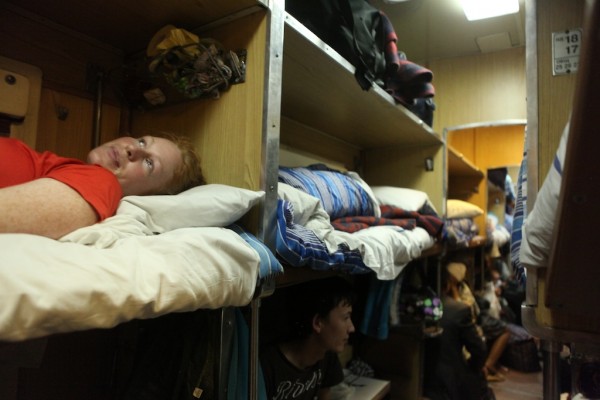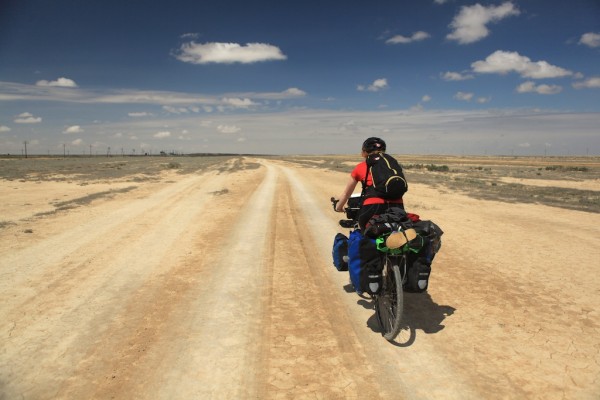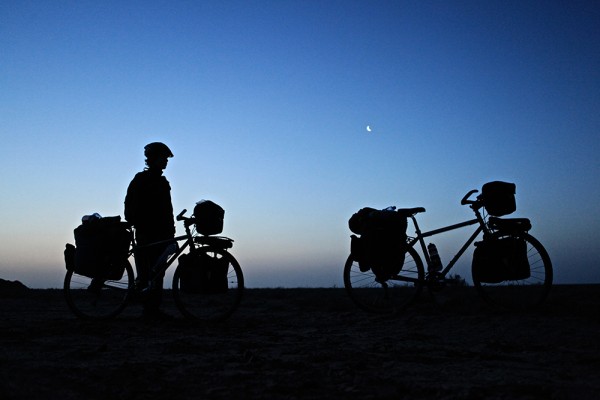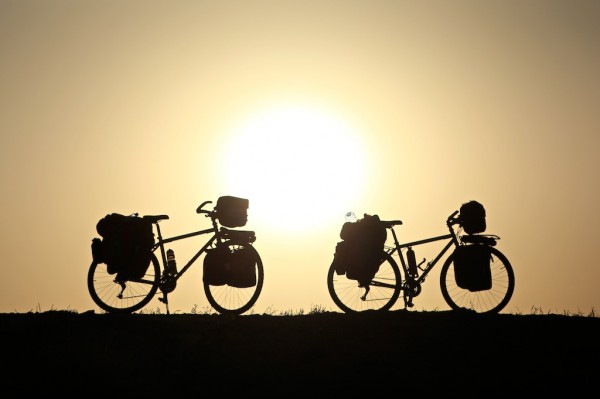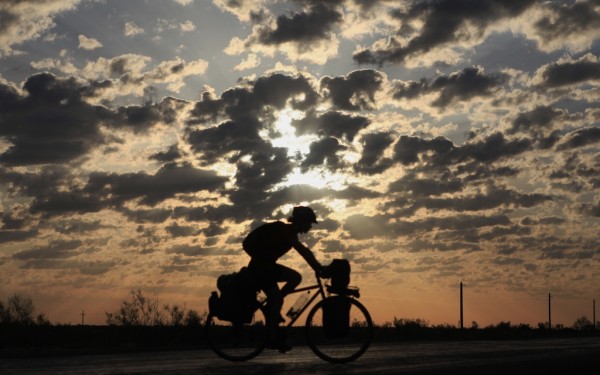There are places you can get to by road, and there are places you can only get to by being on the road, a state of mind you can carry, with concerted effort, to almost any context. Even a train swaying drunkenly on its tracks across Kazakhstan as men sway drunkenly through it, past aisles of people stacked in sleeper bunks like produce on shelves – some fresh, some overripe, some way past expiration.
After nearly a month of chasing down elusive visas, a month of spinning wheels that weren’t our bikes, we definitely belonged in the latter category. Getting sanction to cycle the Silk Road through Central Asia is the modern equivalent of the Great Game, a kind of diplomatic chess where enigmatic rules change on a dictator’s whim, where checkmate is risked with every move to a new country, especially a new ‘Stan. With Cycling Silk we couldn’t apply for visas ahead of time, since at our pace, on a trip this long, they’d expire before we arrived. So we’ve had to snag them along the way, which at times has meant intense frustration and desperate tactics to get where we’ve wanted to go. And there’s nothing like banging your head on borders to learn how impenetrable these arbitrary barriers can be.
The biggest hassle was Uzbekistan, a notoriously closed-off country with a special disdain for independent travellers who might well ride their bikes off the beaten track and write about it afterwards. When our Uzbek ‘Letter of Invitation’ (a prerequisite for applying for a tourist visa) didn’t arrive in Azerbaijan on time, we were forced to fly across the Caspian Sea to Kazakhstan; take a 72-hour train ride across the ninth largest country in the world; spend a week waiting in embassy lines and filling out forms in Almaty; and then board that same 72-hour train back to the Caspian Sea coast.
But once back on track, with visas securely in passports, spring securely in the air, and all of Central Asia’s borders wide open ahead of us, we could relish the charming absurdity that was the trans-Kazakh train. Whole families, generations upon generation, filled the train’s bunks and then some, including the cutest, chubbiest kids we’d ever seen. The origin of their colossal cheeks became clear when we saw how families packed entire kitchens to last the journey’s fast, including a pantry’s worth of food, silver cutlery, and porcelain plates, from which we were served generous portions of deep-fried dough and goat brain soup (we graciously declined the latter).
The kindness of the Kazakh people didn’t end with food. One night my blanket slipped off my bunk while I was sleeping and an elderly woman across the aisle thoughtfully placed it back on me. At which point I screamed, because in my dream it was not a blanket tossed on my legs but an evil, writhing snake. Then I apologized for screaming, thanked her profusely, and tried to explain my startledness in all the wrong languages, with all sorts of mad snakey hand gestures, to grins all around.
Out one side of the train, the breath-fogged windows revealed plains so level the idea of inclination lost all substance; out the opposite side were mountains so steep they folded the notion of flat forever out of sight and sense. Two irreconcilable views of the same world, neatly parsed by the train’s passage. But everywhere the sun was busy pulling green out of the ground, the land newly alive and kicking with life. We felt the same way. As we trundled back toward the Caspian Sea, back to the biking life, to the expedition as we’d originally dreamed it, the return train journey felt like the pause before the conception of a poem, or the silence that anticipates song. We were suspended between tracks, between seasons, all thoughts and worries vagabond, transported in the truest sense. On the road again.
We got off the train in Beyneu, Kazakhstan, and hit the ground rolling toward the westernmost border of Uzbekistan, determined to enter the country the very day our hardwon tourist visa began expiring. It granted us only 30 days to bike nearly two thousand kilometers on rough roads the long way across the country; interview conservationists in the capital city of Tashkent; boot it to the Tajikistan border; and along the way, explore the complexities and challenges of conservation on the Ustyurt Plateau, a transboundary desert straddling westernmost Kazakhstan and Uzbekistan, tucked between the Caspian and Aral Seas, and our second case study of the expedition. So began our evasive maneuvers against the clock – and the heat.
Uzbekistan boasts various blades and poisons, from thorns to scorpions to nightmare-spawning serpents. But for us the heat itself was a kind of venom, effecting paralysis throughout the nerveless high noon of day. And here, high noon lasted all day long, with high winds chiming in as well. Our strategy was to wake to the stars at 4am, ride through dawn, rest out the heat of the day in whatever scrap of shade we could find or make, then bike again until we hit our mileage mark or total dark, whichever came first. Other than days off in the Silk Road outposts of Khiva, Bukhara, and Samarkand, those fabled cities of turquoise and tiles, we kept up this delirious nocturnal rhythm across the entire country.
But if daylight in the desert was a torture to endure, duskier hours made existence not just tolerable, but enchanted. Biking beneath the stars every morning on the Ustyurt plateau was an extraterrestrial experience, our wheels purring on a road paved in night, the moon a chip of ice in the sky. I tucked it beneath my tongue to keep me cool as long as possible, which was never long enough. Then after melting all day, we reconsolidated in the relief of sunset, the sand still glowing hot as stars, dunes drawing new constellations in the night. The horizon seemed to precisely mark the boundary where inner meets outer world – no wonder the urge to chase that line. In these rarefied hours, no speed seemed impossible, no destination too far-fetched. It was like being on the moon or Mars only better, because we could breathe, sing, laugh out loud. Outer space makes you swallow all that.
Outer space is also lamentably bereft of antelopes, at least as far as we know. The Ustyurt, by contrast, is home to the saiga, a critically endangered species of antelope that claims the dubious distinction of being one of the fastest declining mammals on the planet. Poaching is mainly to blame, since the horns of male antelopes are a hot sell on the black market for Chinese traditional medicine. After the collapse of the Soviet Union, communities living on the fringes of the plateau were stranded with scant options for income, so understandably, they hunted saiga both for meat and medicinal sale. Today the saiga are protected by law throughout their transboundary migratory range, but there is paltry enforcement in the remote Ustyurt borderland, especially in impoverished Uzbekistan. The decline of this species, coupled with the drainage of the nearby Aral Sea – caused by intensive Soviet-era and ongoing cotton irrigation – makes this part of the world an extreme example of human-wreaked environmental havoc.
We didn’t see any saiga while we were on the Ustyurt, for those shy and hunted herds are savvy enough to avoid our species. And we didn’t see the Aral Sea either, for its dried shores were still a few hundred kilometres off our route. But in both cases, for better and for worse, these were deeply felt presences. The Ustyurt Plateau that the saiga call home and the Aral Sea are both huge stretches of territory unpopulated by people, ‘barren lands’ marginal to human desire, obtuse to economic exploitation. Local people deem both places wastelands, according to our interviews with conservationists. But deserts like the Ustyurt are beautiful and dynamic ecosystems, with the saiga as their flagship species, while the desertified Aral Sea is a disaster – the consequence of our thirst for cotton, and proof that the only genuinely barren lands are born of us.
The distinction between desert land as wilderness, versus desertified land as devastation, is a subtle but crucial one. Language carries an enormous burden of consciousness, especially when it comes to arguing for the protection of the natural world. Call a wilderness like the Ustyurt a wasteland, and who cares what happens to it? Call saiga horns medicine, and who cares about the rare antelopes that grow them, except as a poachable source of profit? In this way language is a prologue to the possible: it shapes perceptions, and perceptions shape actions, and actions shape our world.
So the way we talk about wild things matters, even though wilderness itself is a concept as evasive as a saiga antelope, or a Central Asian tourist visa, as easily lost in translation as hand signals about snake nightmares. Like life itself, like love above all, wilderness is difficult to define; “it resists the intelligence,” to paraphrase Wallace Stevens, “almost successfully.” But know it when we see it, when we feel it. And perhaps especially when we don’t.
What a haunting fate that would be, though, for us to only grasp what wilderness is and means by its lack. To perceive the wonder of the Ustyurt Plateau only after recognizing the horror of the Aral Sea-turned-Sands. This is what Cycling Silk is fundamentally about: Mel and I are biking our legs and hearts out to do what we can, however puny our individual pedal strokes, to prevent the possibility of a totally tamed planet. To explore how definitions make up the world, and discover what happens – to deserts, to mountains, to minds – when they break down. To bang our heads on borders, at times painfully, to test their fallibility. And to ride into the soul of wildness, our own and the world’s. Even if it takes a train journey or two to finally get there.
—Cormac McCarthy
NEXT: Time to get all tangled up in the Pamir knot, the glorious mess of rock and ice comprising the borderlands of Tajikistan, Afghanistan, China, and Pakistan. We’ll be exploring Marco Polo sheep conservation across borders as our next case study. Bring on the high mountains!

